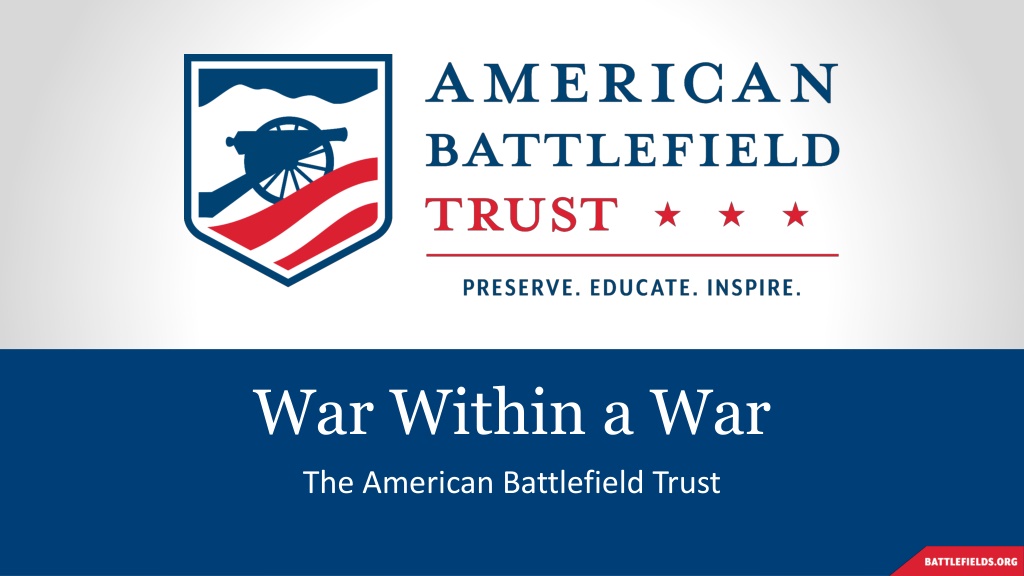Life During the Southern Campaigns of the American Revolution
Explore the complexities of life during the Southern Campaigns of the American Revolution, where communities were divided, partisan skirmishes were common, and guerrilla warfare tactics shaped the conflict. The narrative revolves around citizen involvement, military strategies, infamous figures like Francis Marion and Banastre Tarleton, and the impact on soldiers and their families.
Download Presentation

Please find below an Image/Link to download the presentation.
The content on the website is provided AS IS for your information and personal use only. It may not be sold, licensed, or shared on other websites without obtaining consent from the author. Download presentation by click this link. If you encounter any issues during the download, it is possible that the publisher has removed the file from their server.
E N D
Presentation Transcript
War Within a War The American Battlefield Trust
Inquiry Question: How did citizens choose sides and participate or avoid the tension and conflict during the Southern Campaigns?
What did life look like during the Southern Campaigns? As the American Revolution spread to the South, the conflict became more and more a civil war. Don Troiani
Communities at War In the Southern Campaigns, some battles were fought "traditionally," but many other conflicts happened as partisan skirmishes. Communities divided between Loyalists and Whigs (patriots), and sometimes neighbors fought each other in short combats or surprise attacks. Organized partisan forces attacked British supply lines or Whig-supporting settlements. Because of this viciousness, these final years left a bitter impact in the memory of the survivors and their descendants. Definition: Whig a political party associated with support for American Independence during the Revolutionary War Era.
Life for Soldiers British supply lines now stretched from Ireland to forces fighting hundreds of miles inland from the Southern coast. Their vulnerability motivated attacks by French fleets on the seas and patriot partisans on land. Outnumbered American forces often resorted to raids on British supply lines while avoiding traditional battles. Today, we call this style of fighting guerrilla warfare.
Francis Marion, a patriot commander, was nicknamed the "Swamp Fox" for his daring use of guerrilla warfare. He attacked British supply routes and forts.
One of the most infamous British officers was Banastre Tarleton, accused of allowing his men to kill Patriots trying to surrender after his victory at the Battle of Waxhaws. The stories of his harsh actions fueled division and American resistance.
Soldiers on both sides worried about family members back home. Compare this letter by Patriot General Nathanael Greene and this one by Loyalist officer Stephen de Lancey. What concerns do they share? How are their situations different?
Prisoners of War Prisoners of war on both sides were often poorly treated and lived in harsh conditions. American and British leadership would sometimes organize prisoner exchanges, while civilians might provide charity and relief. Sometimes the legal status of prisoners was unclear. After the Battle of Kettle Creek, South Carolina tried Loyalist prisoners of war as criminals and sentenced them to death. Discuss: What can their story tell us about how prisoners were supposed to be treated? Did the conflict's status as a civil war change how prisoners were treated?
Life for Civilians Patriot, American, Loyalist, and British forces all sometimes harassed the local population for supplies, making conditions worse for civilians. Other times civilians were attacked for their support of a cause or the civilian were simply trapped in harm's way. Compare these accounts from Eliza Wilkinson and the town of Salem, North Carolina: What do they have in common? Where do they differ?
What roles did women play? Women ran households, farms, and businesses while men were away. Women navigated the shifts in power between British and Continental forces, quartering troops, providing supplies, or passing along intelligence. Rebecca Motte, a patriot plantation owner, supplied American forces and even helped destroy her own home to prevent its use by the British.
According to Legend... Nancy Hart, a Georgia frontierswoman, served as Patriot spy gathering information from British camps. She defeated six British soldiers who entered her home with only the help of her twelve- year-old daughter, Sukey. (We know some of this story is true... and six skeletons have been found on Nancy's land.)
"It is beneath the character of the independent State of North Carolina to war with women and children. The authors of our ill treatment are the proper subject of our own and the resentment of the public. Does their resentment barbarity strike us with abhorrence? Let us blush to imitate it; not justify by our own practice what we so justly condemn in others." - Petition to Governor Martin from the "Ladies of Wilmington"
Choosing sides The American Revolution provided unique opportunities and risks to African Americans and Native Americans. Many fought on both sides because they believed in the cause as well as to protect their own freedom and land. Don Troiani
What roles did Native Americans play? More Native Americans aligned with the British and Loyalists than with the Patriots, because the British promised protection of their lands. The Choctaw, Chickasaw, and Cherokee all aligned with the British. The Catawba, however, aligned with the Patriots. From 1776-1777, the Cherokee War was fought between Patriot settlements and most Cherokee tribes along the western border of the southern states. Many Native Americans remained neutral throughout the conflict.
James Armistead Lafayette While many enslaved African Americans won their freedom by joining British forces, many served the Patriot cause as well. James Armistead, an enslaved Virginian, pretended to pass information to British General Cornwallis but instead acted as a double agent for General Washington. Armistead remained enslaved until 1787 when he received his manumission from Congress with the help of the Marquis de Lafayette. He changed his name in Lafayette's honor.









































